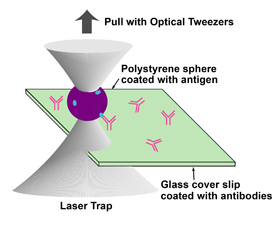Innovative "tweezers" are so sensitive that they are able to detect very small concentrations of disease-causing agents in blood samples, without the need to disinfect them before - or even to hold them in the hand - since they are temporary and even weightless.

The National Institute of Standards and Technology (NIST) received a patent for a method of using "optical tweezers" to identify and measure extremely low concentrations of biological material - such as a virus on a surface. The Institute granted a non-exclusive license to use this technology to a healthcare services company (Haemonetics) that markets blood treatment technologies to hospitals and companies that manage blood and plasma collections.
Optical tweezers are actually highly focused laser beams. They are able to capture certain objects, such as latex microspheres or biological cells and move them in water. This occurs due to the reaction of the electric fields produced by the laser with the electric charges on the objects.
In order to identify disease-causing substances, researchers are able to coat a microsphere with antibody particles and then bring it close to a surface containing infectious particles (antigens). At this stage, the antigens bind to the antibodies anchored to the sphere, similar to a velcro strap, when the loops on one strip are caught by the hooks on the other strip. By measuring the laser power required to remove the microsphere from the surface, it is possible to calculate the amount of force required to break the bonds between the antibodies and the antigens and hence - to calculate the total number of antigens associated with the sphere. As a result, it is possible to identify and calculate biological antigens at extremely low "femtomolar" concentrations - approximately - one antigen particle in one million billion parts of water.
As a continuation of previous research done on optical tweezers in the industrial and academic research communities in the 1997s, the technology became patent protected in 5620857 (USXNUMX) as a result of research conducted at this national institute. The inventors are: Howard Weetall, Kristian Helmerson and visiting researcher Rani Kishore.

3 תגובות
Rather it is written how it works at the maximum level of detail that an "ordinary person" can understand.
The article reviews all the possibilities inherent in the development, including that it is protected as a patent, except for the important thing for the common man, how it works so that it is possible to use the device.
Simply ingenious